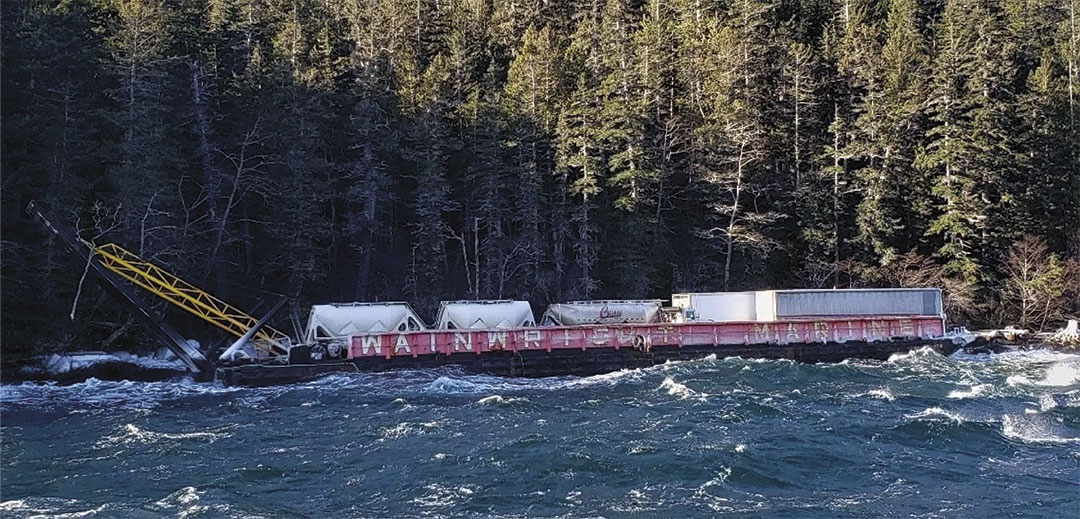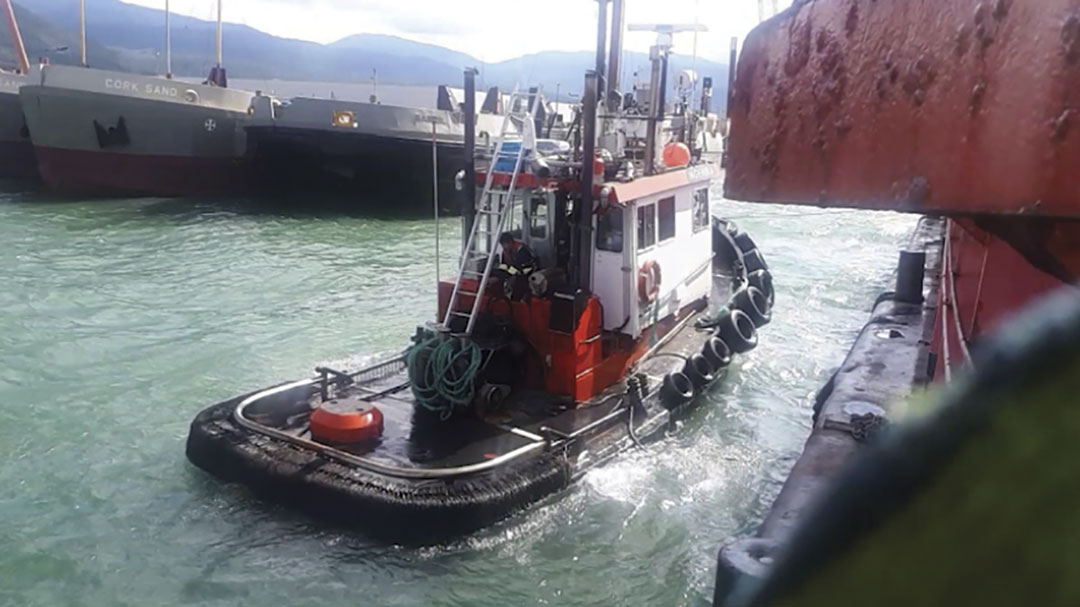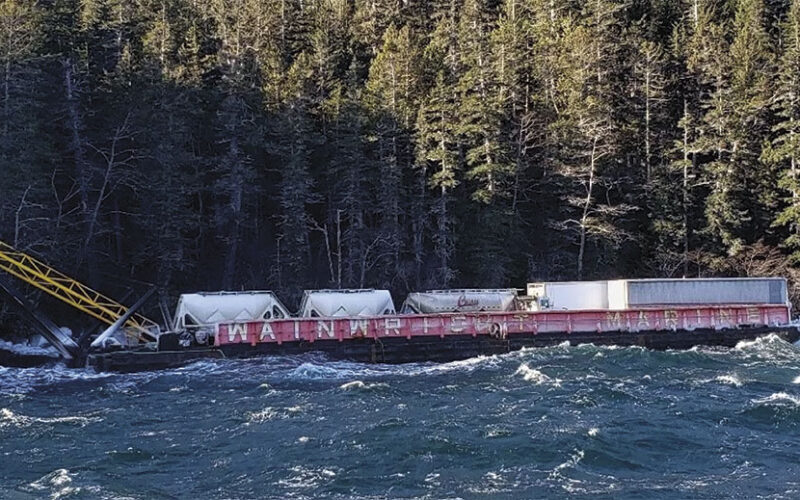
On Feb. 10, 2021, the tugboat Ingenika was rounding Europa Point, outbound from Kitimat, B.C., when it steered straight into a 40-knot wind.
Battered with frozen spray, the tug struggled in increasingly heavy seas as it towed the Miller 204, a 200-foot barge loaded with construction equipment, dry cement, and other materials for a large hydroelectric power plant in the remote British Columbia community of Kemano.

The little 36-foot tug, operated by Wainright Marine Services, lost speed and fought in frigid conditions and a 2-mph ebbing tide to make its way through the Gardner Canal. About 20 minutes after rounding the Point, the vessel abruptly heeled to starboard and sank some 16 miles from its destination.
Capt. Troy Pearson and deckhand Charley Cragg died, while deckhand Zac Dolan, survived by swimming to a life raft. He eventually reached the shore, frostbitten and suffering from hypothermia.
Canada’s Transportation Safety Board (TSB) could not say definitively why the vessel heeled over at about 10:45 p.m. However, it suggested seawater ultimately entered the tug through exhaust vents and flooded the engine room.
Investigators determined both Pearson and Cragg were wearing their immersion suits, although the suits were not fully zipped and the head covering hoods were not raised. “The inflatable head supports were uninflated, and the suits were saturated internally with water and ice. The gloves for the master’s suit were found stowed in the sleeves,” the report said.
The TSB suggested the 700-hp Ingenika was underpowered for the conditions and it lacked sufficient power to make headway against the strong winds and tide. The TSB also raised the possibility Miller 204 got off the tug’s starboard side and pulled it over – a situation known as girding.
“As the tug and barge were making the turn around Europa Point in opposing wind and current with a reduced effective bollard pull, the drag force of the barge may have led the tug to heel over and the deck edge to submerge, resulting in down flooding through deck openings and the vessel sinking,” the agency said.
Pearson had spoken with Wainwright Marine’s owner before departing Kitimat to discuss the weather and had checked the weather on his phone and tuned the tug’s VHF radio to receive marine weather forecasts before Ingenika got underway with Miller 204 at about 3:45 p.m. on Feb. 10, 2021.
Following seas aided the tow during the initial leg of the voyage with the tow making about 9 knots for several hours, although it had slowed to 7.3 knots by about 7 p.m.
Twenty minutes later, the tug’s speed fell further to 5.8 knots. Pearson checked in with the owner via satellite phone and said the tow would reach Kemano on schedule.
The waves picked up soon afterward and Ingenika began losing headway near Rix Island, south of Kitimat on the Gardner Canal. Things went tragically downhill from there.
“At 9:52 p.m., as the tug and barge were rounding Europa Point, the tug’s speed dropped to below 1 knot,” the TSB report said. The tug then regained some speed, but about 20 minutes later, it dropped below 1 knot again.
“At some point,” the report continued, “there was a loud bang and (Dolan)…was suddenly thrown against the starboard side of the hull. When he stood up, he had to balance himself because the tug was heeled over to starboard by approximately 30 degrees.”
Cragg and Pearson attempted to don their immersion suits as water poured into the wheelhouse, but Dolan didn’t have time to get his suit on before the crew abandoned ship, the report said.
The three huddled together in the 41-degree water, but they were unable to see the barge from their position on the sinking Ingenika’s port side. Dolan later swam to secure the life raft, which inflated soon after the tug sank.
Dolan “called the master and (Cragg) to join him, but they did not respond. He then “periodically activated the life raft’s flares to signal for help,” the report said. “After drifting for approximately 30 to 40 minutes, the life raft reached the shoreline. (Dolan) went ashore to seek shelter in the forest.”
An emergency position-indicating radio beacon activated at 11:43 p.m. with the vessel Inkster reaching the location three hours later. Both Pearson and Cragg’s bodies were recovered. Dolan was rescued by a private helicopter crew and taken to a hospital for treatment and the grounded Miller 204 was soon located.
The Ingenika sank in more than 550 feet of water, and though the Royal Canadian Mounted Police used a remotely operated vehicle to search for it, the vessel could not be located.
The TSB found no records indicating the tug had been inspected at any time over the past 50-plus years. Ingenika, built in 1968 and of 14.06 grt, was subject to Transport Canada regulations drafted in the 1960s that mandated quadrennial inspections of tugs that measured more than 15 and less than 150 GRT.
Although Wainwright Marine operated under a company-wide safety management system, investigators identified gaps in the program and an inconsistent application by its captains. For instance, safety drills were rarely conducted aboard Ingenika, the report said, and the vessel’s immersion suits were not regularly inspected and maintained.
The tug’s crew also did not typically practice putting on the suits with investigators suggesting that fact contributed to crewmembers zipping them only partially. “The immersion suits on two of the crew members were only partially donned, which resulted in cold water entering the suits and caused the crew members’ deaths by hypothermia and subsequent drowning,” the report said.
Attempts to reach Wainwight Marine for comment on the TSB findings were unsuccessful. According to recent press accounts from Canada, the company is facing criminal charges and fines stemming from the fatal sinking. •

